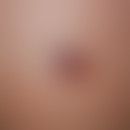Synonym(s)
DefinitionThis section has been translated automatically.
Name for a complex consisting of a heterodimeric transporter protein, of the peptide of endogenous, viral or microbial origin to be processed, of MHC-I molecules as well as of 4 chaperones (calnexin, Erp57, calreticulin, tapasin). The peptide loading complex plays a central role in the endogenous antigen/allergen presentation (endogenous antigen-MHC class I presentation pathway).
General informationThis section has been translated automatically.
In the cytosol and in the nucleus of every cell, the degradation of cytosolic proteins recognized as foreign is mediated in a complex process via the so-called proteasome complex(also called proteasome), a macromolecular "shredder". This produces a large number of protein fragments, peptides, which are brought into the endoplasmic reticulum (ER) via a membrane so that they can be presented on the cell surface. This important transport and subsequent loading of the MHC-I molecule is carried out by a membrane-bound macromolecular machine, the peptide loading complex (PLC).
Via the chaperones, the PLC enables optimal folding and stabilization of the MHC heterodimer and its loading with the folded high-affinity peptides. After binding of the peptide to the MHC-I complex, the chaperones are released: the newly formed peptide-MHC-I complex leaves the endoplasmic reticulum in vesicular structures. These cross the Golgi apparatus and fuse with the cell membrane. Thus the peptide-MHC-I complex can be presented on the cell surface and can be recognized by the specific TCR (receptor) of CD8-positive lymphocytes.
In the MHC-I presentation pathway, antigen processing involves cytosolic proteins of endogenous, viral or microbial origin. The process of presentation via the MHC-I molecule provides the basis for the differentiation of endogenous fragments from foreign bodies, pathogens and tumour cells.



